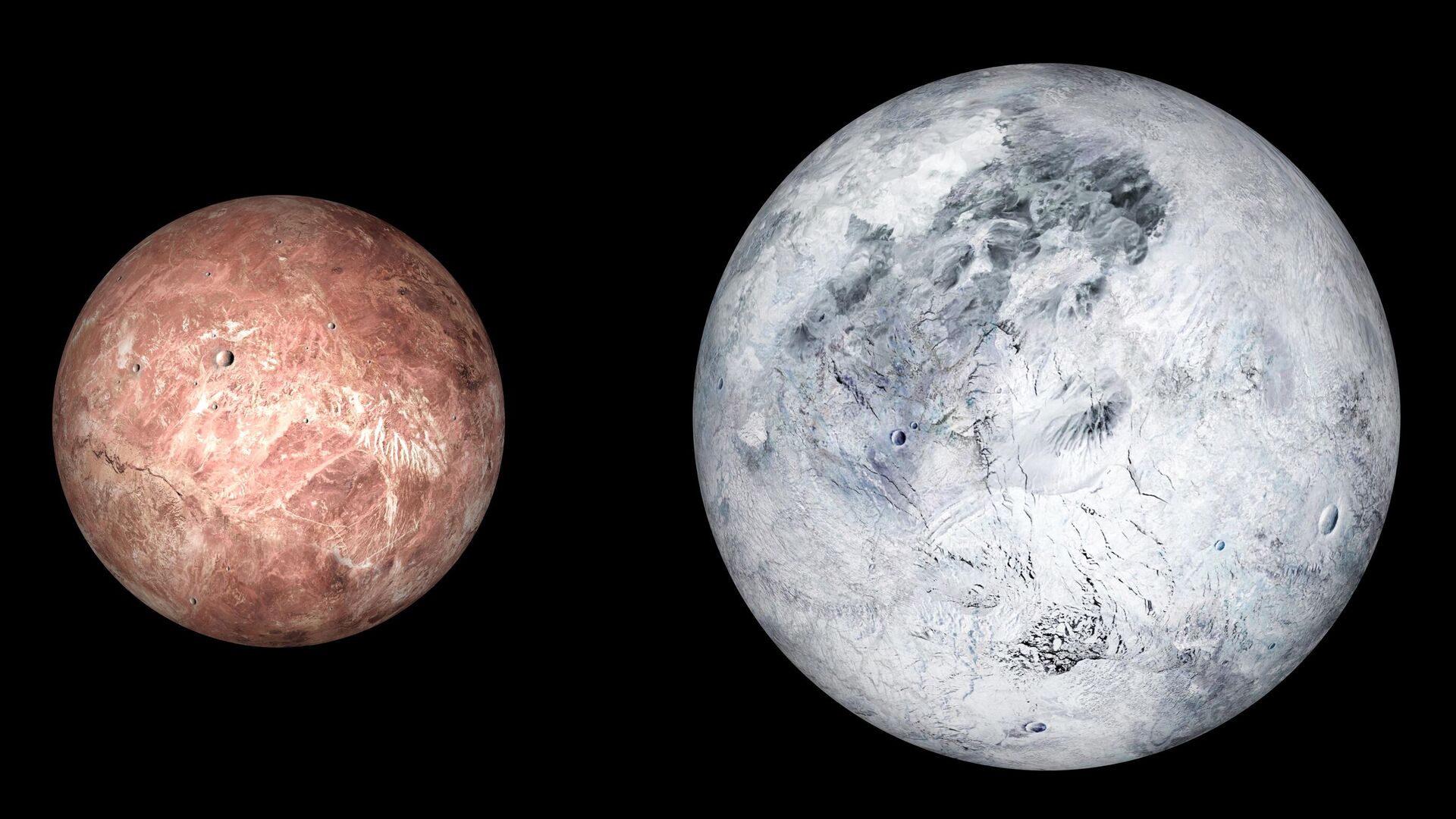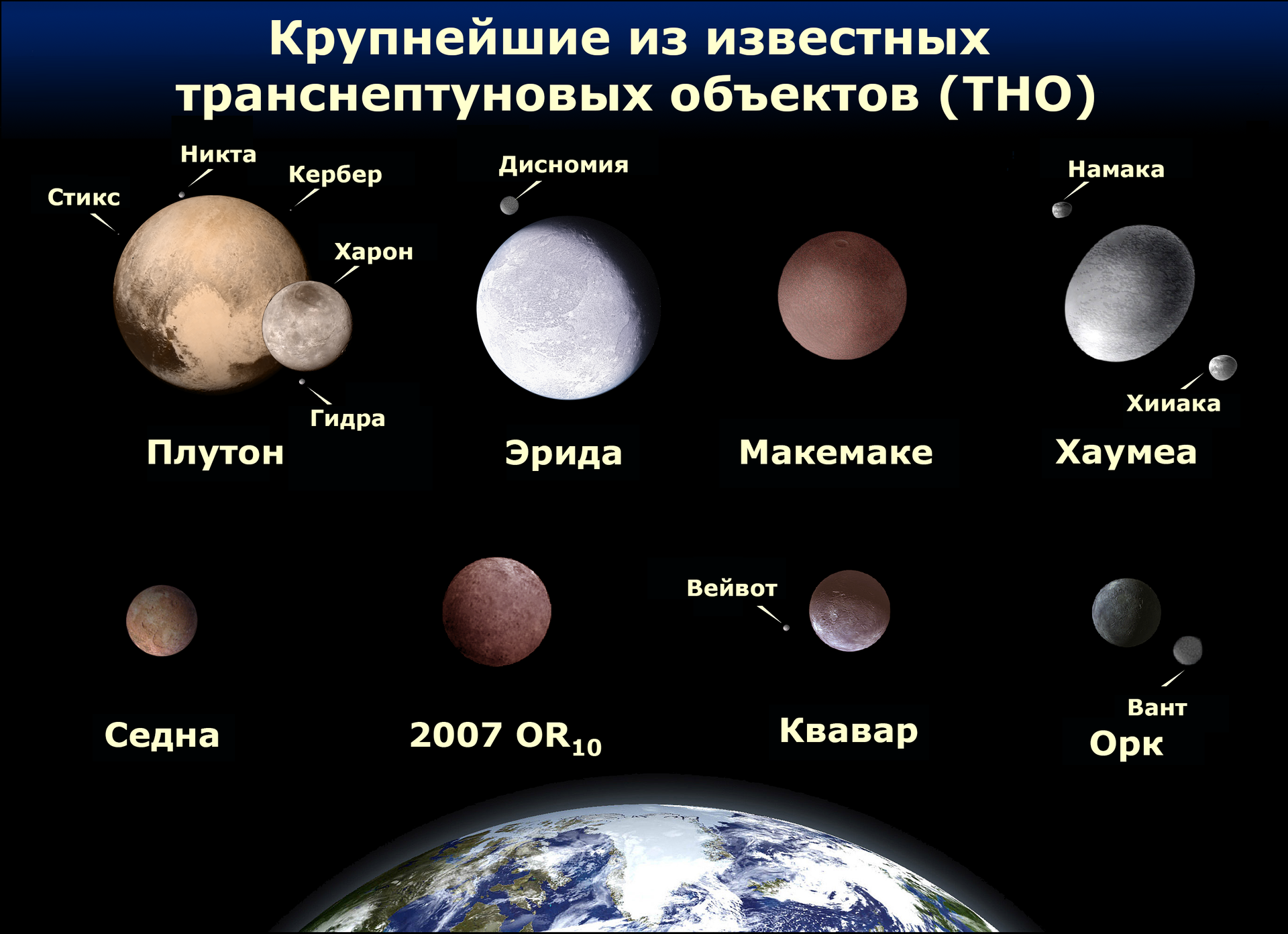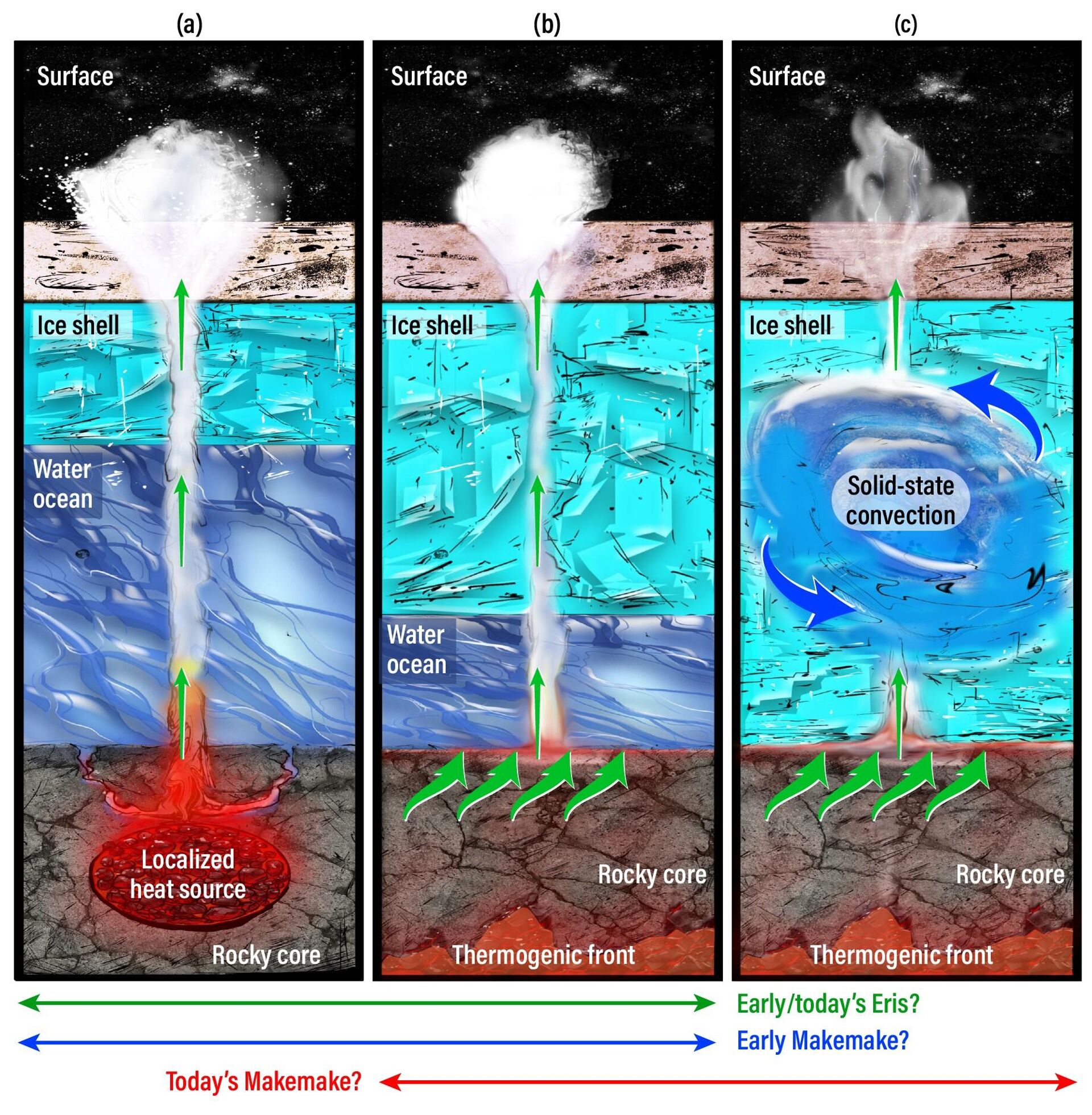
< br />
MOSCOW, February 28, Vladislav Strekopytov. Astronomers suspect that two icy dwarf planets in the Kuiper belt have hidden oceans of liquid water, according to data obtained by the James Webb Space Telescope. If the hypothesis is confirmed, then the idea of such celestial bodies will change dramatically.
The Last Frontier
About 4.6 billion years ago, the Solar System formed from a cloud of gas and dust. The bulk of the matter went to form the star and planets, and the remnants of the material ended up on the outskirts of the system. Another planet could have formed from them, if not for the presence of the giant Neptune nearby. Its gravitational influence prevented the scattered pieces of stone and ice from connecting. So they rotate outside its orbit in the form of a debris belt named after the Dutch-American astronomer Gerard Kuiper.
Unlike the rocky main belt asteroids, most Kuiper Belt Objects (KBOs) are icy bodies of frozen methane, ammonia, and water. Their sizes range from several meters to two thousand kilometers or more. Astronomers now know more than two thousand OPCs. The largest received the status of dwarf planets: Pluto (2376 kilometers in diameter), Eris (2326 kilometers), Makemake (1430) and Haumea (1632).
The only spacecraft to study Kuiper Belt objects at close range was NASA's New Horizons probe. It was launched in 2006, nine and a half years later it reached Pluto, and in 2019 it flew past the mysterious double asteroid Arrokoth. Located 44.6 astronomical units (AU) from the Sun, or 6.5 billion kilometers from Earth, this KBO is the most distant solar system object ever visited by a spacecraft.
Now the New Horizons station is located at a distance of more than 58 a. e. from the Sun and continues the search. The data that the device sends to Earth indicates that at such a great distance the density of interplanetary ice dust is still very high. Previously, it was believed that the outer boundary of the Kuiper belt, beyond which the dust density drops sharply, passes at a distance of approximately 50 AU. e.
«James Webb» and subglacial worlds
After the New Horizons station practically left the Kuiper Belt, the main tool for studying its objects was the James Webb Space Telescope (JWST), sent into orbit in December 2021.
This is the largest and most powerful space telescope launched by mankind. It is capable of detecting relatively cold planetary bodies located at distances up to 100 AU. e. from the parent star, and also receive the spectral lines of these planets. No other telescope can do this yet.
The NIRSpec infrared spectrograph on the JWST telescope last year analyzed the composition of one of the water geysers on Enceladus. It is believed that under the ice shell covering the surface of this satellite of Saturn there is a subglacial ocean, from which liquid fountains periodically break through. NASA scientists once said that Enceladus is “the most suitable place for life as we know it in the solar system beyond Earth.”
Another planetary body with a subglacial ocean that may also harbor microbial life, — Europe. It is planned that NIRSpec will receive high-quality images of this moon of Jupiter, which will be used to search for regions with geysers and high geological activity.
Quite unexpectedly, thanks to JWST observations, two small bodies from the Kuiper belt were added to the list of objects with potentially habitable subsurface oceans — the dwarf planets Eris and Makemake.
It was believed that all KBOs were dead and cold, but, as it turned out, this is wrong. After analyzing data on the isotopic composition of methane on the surface of Eris and Makemake, scientists from the JWST team came to the conclusion that it has signs of hydrothermal origin, which means that activity remains in the depths of these planets. The results of the analysis were published in two articles in the journal Icarus (Article 1, Article 2).
< br />
Distant and hot
Eris, the second largest after Pluto, is the most massive dwarf planet in the Solar System and the farthest from the Sun. Spectroscopic observations carried out in 2005 at the Gemini Observatory in Hawaii revealed methane snow on its surface. In this way, it is similar to Pluto and Neptune's satellite Triton.
Makemake is almost half the size of Eris and is comparable in size to Pluto's satellite Charon. The Spitzer and Herschel space telescopes found that its surface is also covered in snow, although there are small dark areas. In addition, during spectrometric observations on Makemak, ethane, nitrogen and carbon monoxide were discovered in solid form.
The NIRSpec instrument on the JWST telescope is capable of determining isotopic and isotopological compositions. Isotopes are atoms of the same element that have different masses. Molecules of the same substance that differ in the isotopic composition of their atoms are called isotopologues. Obtaining this information is essential to understanding the origin of the substance and geological history. Thus, by the isotopic composition of hydrogen in methane, one can determine whether it was formed in the depths of the planet or on its surface, whether it is primarily biogenic or abiotic, hydrothermal in nature.
By measuring the ratio of deuterium to ordinary hydrogen (D/H) on the surface of the planets, scientists have determined that the methane from which the snow was formed has signs of hot deep origin.
January 30, 08:00
“At the start of this project, I thought that large Kuiper belt objects must have a composition inherited from the primordial solar nebula, and their cold surfaces retain ancient volatiles such as methane,” one of the study’s authors, Dr. Christopher, was quoted as saying in a press release. Glein of the Southwest Research Institute, US, «Instead, the JWST space telescope gave us a surprise. We found evidence pointing to thermal processes producing methane inside Eris and Makemake.»
The D/H values recorded by the NIRSpec spectrometer are significantly lower than those characteristic of the primordial cold methane of the protoplanetary cloud. They indicate that this gas was formed at high temperatures (more than 150 degrees Celsius). Scientists have obtained similar isotopic evidence for molecular nitrogen.
Researchers are confident that methane and nitrogen were formed as a result of deep hydrothermal processes involving liquid water. Assuming that the cores of Eris and Makemake are still hot, there may still be hidden oceans beneath their icy surfaces, theoretically suitable for life.
Paradigm Shift
The authors offer three scenarios for how deep methane came to the surface. In the first version, it was formed in underground pockets of molten rock, made its way through the thickness of the subsurface ocean and reached the surface through cracks in the ice shell.
In the second version, radiogenic processes in the core, leading to heating of the interior, caused hydrothermal circulation at the bottom of the ice-covered ocean with the formation of abiotic methane. An option is also possible without the participation of the liquid ocean. Thermogenic methane could be generated as a result of solid-state convection in the ice column, and delivered to the surface during cryovolcanic processes.
Scientists are inclined towards the hydrothermal origin of methane. Moreover, carbon isotope ratios indicate that this happened relatively recently. There may still be a hot ocean bubbling beneath the icy crust covering the two dwarf planets.
“The possibility of subsurface oceans and the discovery of rare methane isotopologues on these distant worlds challenge the generally accepted view of the unchanged primordial composition of large trans-Neptunian objects,” notes Another author of the articles, University of Central Florida professor Noemi Pinilla-Alonso, “The discovery not only changes our understanding of these icy worlds, but also highlights the key role of endogenous forces in the formation of the bodies of the outer solar system as a whole.”
According to the researchers , the data obtained can become the starting point for a paradigm shift in planetary science. If we assume that other planetary bodies that were considered cold are actually warm inside, then Pluto and other icy worlds on the outskirts of the solar system become promising for the search for possible life. Not to mention Saturn's moon Titan, which has a lot of liquid methane on its surface.





















































Свежие комментарии